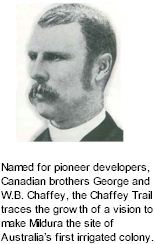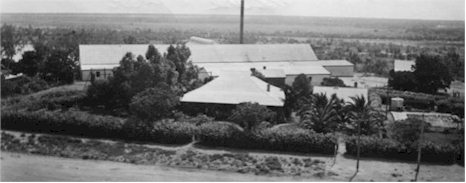


William Benjamin Chaffey (born in 1856 in Brockville, Ontario) was a Canadian engineer who with his brother George, developed the California cities of Etiwanda, Ontario, and Upland, as well as Mildura in Victoria. He established irrigation companies in both Mildura and in Renmark, where he is still held in veneration. His company, Chaffey Brothers Ltd, went into liquidation in 1894. He remained in Mildura, becoming mayor in 1920, establishing an orchard, and the Mildura (later Mildara) Winery Pty Ltd.

In 1953 Mildara's Managing Director Ron Haselgrove, bought 12,735 litres of Coonawarra red wine from Bill Redman. Ron recognised that the Coonawarra could produce classical, elegant Cabernets and in 1955 he purchased the Company's first 12.5ha of the Coonawarra's famous Terra Rossa soil. Mildara was the first major winery to invest in the Medoc of the South.
In 1958 Ron Haselgrove assembled an experimental blend of 50% Coonawarra Shiraz and Cabernet and 50% Hunter Shiraz to make a wine that still ranks as one of Australia's finest. In 1966 the first Coonawarra Cabernet Shiraz Malbec was produced. Mildara had interplanted Malbec with Cabernet Sauvignon in the manner practised in Bordeaux.
Many successes followed, notably the Montgomery Trophy for Best Dry Red Table Wine at the 1984 Royal Adelaide Show. These acclaimed early blends were forerunners to Jamieson's Run which was launched in 1987 to celebrate Mildara's centenary. Mildara Wines purchased the Wolf Blass group in 1991 to form Mildara Blass, a publicly listed company.
In 1996 Fosters Brewing group completed the acquisition of Mildara Blass but Mildara continues to operate as a more-or-less separate entity. Mildara Blass has focussed on the upper end of wine markets, enjpying an estimated 9% share of the domestic market for bottled wine in 1996 but some 30% share of its targeted premium market.
The US is Mildara's major export marketing taking around 350,000 cases per annum or over 50% of the group's exports. Its wines are marketed there under the Black Opal and other related labels. Mildara Blass exports to more than 70 countries worldwide. In 1997/98 Mildara exported over 1,000,000 cases of premium wines, showing a 25% growth in exports over the past year.
In 2005 McGuigan Simeon bought Mildara's second winery at Merbein located in Victoria's Sunraysia. A significant event for the the local winegrowers, Mildara at Merbein was the major distribution and packaging centre for Beringer Blass and McGuigan Simeon plans to keep the winery at Mildura as head of its export operations.

























